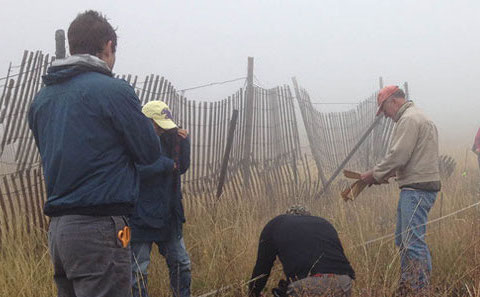
Montana State University researchers Jack Brookshire (left) and Tad Weaver (in red cap) collect samples with students in the Bangtail Mountains north of Bozeman, Mont.
By The Daily Climate staff
BOZEMAN, Mont. – More than 40 years’ of evidence from a mountain meadow shows that increasing carbon dioxide levels don’t help plants.
In fact, the opposite is true: Grassland productivity today in one Montana meadow is half of what it was in 1969, when AM ruled the airwaves and atmospheric carbon dioxide concentrations were 327 parts per million, 20 percent lower than today’s.
Researchers concluded that increasing aridity in the greater Yellowstone ecosystem countered any gains plants might have enjoyed from the increased carbon dioxide.
Long-term results
“Our long-term results of declining grassland production contrast with the results of some models and short-term experiments,” said Jack Brookshire, a professor at Montana State University who co-authored the report, published last week in the journal Nature Communications.
The debate over the fertilizing effects of carbon dioxide and, to a lesser extent, warmer temperatures, has fed a theory by those arguing against emissions reductions that human-driven climate change could be beneficial.
The U.S. Department of Agriculture reported last year, for instance, that more carbon could increase yields of wheat, rice and soybeans by up to 15 percent.
But those studies often fail to consider other impacts, such as rainfall or extreme weather.
That was the case in the Montana meadow, Brookshire said in a statement.
“Dryness over the last several decades is outpacing any potential growth stimulation from increasing atmospheric carbon dioxide and nitrogen deposition,” he said.
Windswept meadow
From 1969 to 2012, Montana State researchers visited a U.S. Forest Service meadow in the windswept Bangtail Mountains about 25 miles from Bozeman. They measured plant productivity, determining the influence of carbon dioxide and nitrogen enrichment, and used snow fences to artificially increase the snow in areas.
While deer and elk had access to the meadow, the area hasn’t been grazed since the 1930s, Brookshire said.
“Our results demonstrate lasting consequences of recent climate change on grassland production,” concluded Brookshire and co-author Tad Weaver, an emeritus ecologist at Montana State who initiated the study.
The evidence also underscores the value of long-term research and, they wrote, “the importance of understanding past climate-ecosystem coupling to predicting future responses to changing climate.”
+++++
The Daily Climate is an independent, foundation-funded news service covering energy, the environment and climate change.
